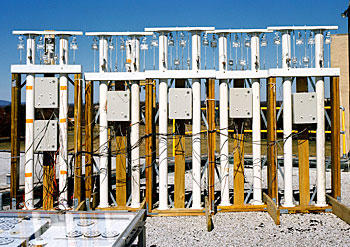
Just as a chain is as strong as its weakest link, a building is as secure against the environment as its most degraded joint sealants, about 50 percent of which fail in less than 10 years after installation.
The upshot for U.S. homeowners is that moisture damage due to failed sealants is responsible for much of the $65 billion to $80 billion they collectively shell out for house repairs annually.
Researchers at the National Institute of Standards and Technology (NIST) are assembling a toolkit of measurement devices and scientific data that will help manufacturers of sealants systematically improve the protective performance of their products. Their latest contribution, described in the current issue of the Review of Scientific Instruments, is an outdoor testing system that tracks real weather conditions—by the minute—and measures the squeezing and stretching that occur in sealants as the building moves with temperature changes.
The NIST-developed testing devices could supplant current methods, which essentially entail exposing sealants to the elements for extended periods with no movement and then visually inspecting the materials for cracks and other signs of degradation. Using materials that can be purchased at the local hardware store—such as wood, PVC pipe and toilet flanges—and combining them with arrays of load and environmental sensors, NIST research chemist Christopher White and his colleagues built a state-of-the-art testing system representative of real-world conditions.
In construction, sealants are used to close gaps between building materials—usually unlike materials, such as steel and glass or wood and concrete. Different materials expand and contract differently in response to changes in temperature, relative humidity and other conditions. Because of these differences between adjacent materials, sealants are regularly stretched, compressed and, in effect, pulled in different directions.
All that motion, White says, can cause the material equivalent of fatigue, tearing and adhesion loss, allowing the water to breach the sealant defense.
"When you apply a sealant to a building joint—such as between window glass and steel in the building frame—you are trying to seal displacements that occur because the materials expand and contract at different rates," White says.
"These new and very inexpensive testing devices," he explains, "induce movements that are very similar to what a sealant would see in the actual application, in a building."
Designs of the experimental testing devices have been shared with a consortium of U.S. sealant manufacturers who have already adopted this new technology. Additionally, these designs are incorporated in a new ASTM draft standard soon to be put to vote.
C. C. White, K. T. Tan, E. P. O'Brien, D. L. Hunston, J. W. Chin and R. S. Williams. Design, fabrication, and implementation of thermally driven outdoor testing devices for building joint sealants. Rev. Sci. Instrum. 82, 025112 (2011); doi:10.1063/1.3543817

